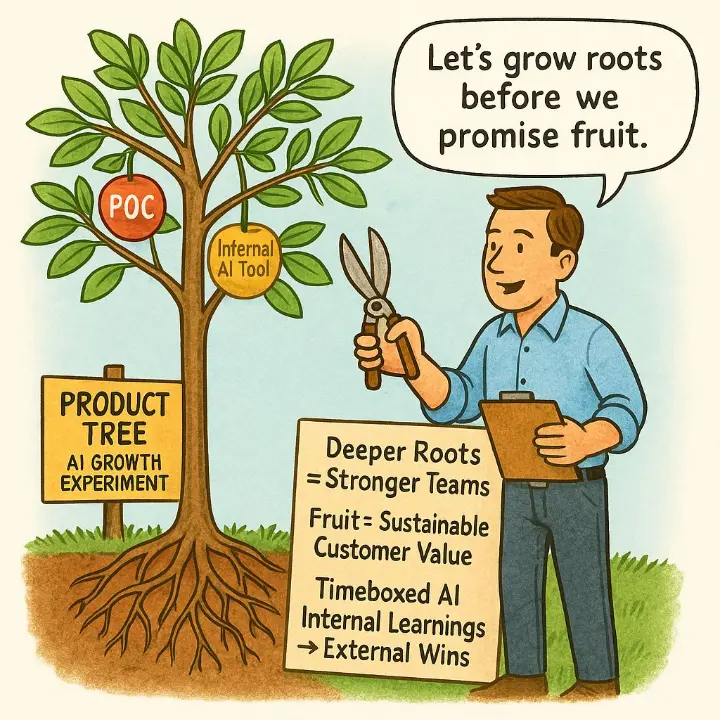Key Message: Long-term AI success starts with deep organizational roots, not just flashy experiments.
The Tree Analogy: Grow Roots, Prune with Purpose
Too many companies jump into AI like it’s a race to scale. But growth without direction leads to tangled messes with fragmented tools, forgotten pilots, and exhausted teams.
Think of your organization like a tree. The CEO is the caretaker. Their job? Nurture deep roots and prune early fruit. The tree itself, your systems, teams, processes needs to grow in alignment with where the sunlight is, not just sprout branches in every direction.
The early fruit? Those are your PoCs and workshops. They’re important but if left dangling too long, they sap energy from deeper, more valuable growth. You don’t build strength from a flashy win. You build it from structured, rooted learning.

Beware the Flywheel Trap
In the early cloud-native boom, everyone wanted to build momentum. The flywheel effect was everywhere: just get it spinning and magic will happen. But what happens when everything becomes a product? You end up with 50 fractional features, none of them supported, owned, or measured.
I’ve walked into orgs with thousands of ungoverned tools, apps, and dashboards each created in good faith, but few adding value anymore. No one knows who owns them. No one knows if they’re worth keeping. And no one wants to touch them.
The truth is: the flywheel works for product features, not entire organizations. We’re now in the age of product consolidation more value, more capability, same spend. So if you’re chasing AI wins, ask yourself: does this effort roll up into something bigger? Or is it just another pet branch starving the rest of the tree?
Culture Before Code: The Fear of Elimination
Here’s the hard truth most execs don’t talk about: your people aren’t resisting AI because they don’t believe in it. They’re resisting because they think it will eliminate their role and no one’s told them otherwise.
If you want people to automate, you need to give them psychological safety. They need to know that building a system that removes their manual work doesn’t mean they’re out of a job. It means they’re moving to higher-impact work. If that message isn’t loud and clear from leadership, you won’t get real adoption.
The irony is: the people who are best positioned to improve a system are often the ones closest to it. But they’ll never tell you how if they think it puts a target on their back.
Leader-Leader Thinking: “I Intend To…”
The old command-and-control model doesn’t work in a modern AI-driven environment. Teams need autonomy with alignment. That’s where the leader-leader model comes in. Empower people to say:
"I intend to experiment with [X] for the purpose of [Y], so we can improve [Z]."
This structure changes everything. It gives people ownership, ties actions to outcomes, and lets leadership set direction without bottlenecking progress.
We saw this during the cloud-native wave. Teams that embraced this approach moved faster, experimented more, and adapted better. The ones that didn’t? They dug in their heels, betting the transformation would blow over. It didn’t.
Today’s AI transformation is no different. If your people aren’t experimenting, it’s not because they’re lazy it’s because no one gave them a safe framework to do it.
Cross-Pollination and Organizational Flow
Experiments are great. Shared experiments are better. The real unlock comes when small strike teams run fast tests, then rotate across the org to spread what they’ve learned.
This is how you build organizational agility by letting knowledge move faster than people do. Google figured this out early. They shift people around constantly to avoid tunnel vision. It’s how they stay creative and adaptive.
Don’t silo your AI progress. Build a rhythm of experimentation, reflection, and knowledge transfer. Not everything has to scale but the learnings should.
Conclusion: Grow What Matters
Flashy demos don’t make a strong organization. Deep roots do. You grow them by focusing on:
- Purpose-driven experiments
- Psychological safety
- Pruning non-strategic wins
- Empowered teams with aligned autonomy
- Cross-team knowledge sharing
So ask yourself: are you building something that’s going to last, or are you chasing the next low-hanging fruit?
If you want to build something real start at the roots. Then grow wide, slow, and strong.
Let’s Chat
Want to have a real heart-to-heart about how your org can actually do this? Whether you’re at the start of your journey or trying to rein it back in, I’m always up for a grounded conversation. Shoot me a message no slides, no fluff, just real talk about where you are and where you want to grow.